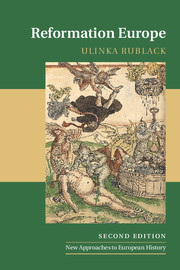Luther and Lutheranism
An excellent brief guide is Kaufmann, Thomas, A Short Life of Martin Luther (London, 2016), to be supplemented by his Luther’s Jews: a Journey into Anti-Semitism (Oxford, 2017). The most original recent biography is by Roper, Lyndal, Martin Luther: Renegade and Rebel (London, 2016); another important biography written by a historian is Schilling, Heinz, Martin Luther (Oxford, 2017). Brecht, Martin, Luther (Minneapolis, 1993–9), is the most detailed, factual biography in three volumes; Oberman, Heiko A., Luther: Man between God and the Devil (New Haven, 1989) is a classic which brings out well the extreme importance of the devil in Luther’s thought. Kolb, Robert, Dingel, Irene and Batka, Lúbomir (eds.), The Oxford Handbook of Martin Luther’s Theology (Oxford, 2014) is particularly wide-ranging and up-to-date. Many of the reformer’s written or spoken words, including sermons and the table talk, can be read in English in Pelikan, J. and Lehmann, Hartmut (eds.), Luther’s Works: American Edition, 55 vols. (St Louis, MO and Philadelphia, 1955–). Karant-Nunn, Susan and Wiesner-Hanks, Merry have helpfully edited the excellent Luther on Women: a Sourcebook (Cambridge, 2003).
The best introduction for the German Reformations is Brady, Thomas A. Jr., German Histories in the Age of Reformations (Cambridge, 2009). Karant-Nunn, Susan’s work has been pioneering; see her The Reformation of Feeling: Shaping the Religious Emotions in Early Modern Germany (Oxford, 2009), as well as her The Reformation of Ritual: an Interpretation of Early Modern Germany (Oxford, 2009).
Essays by Robert William (Bob) Scribner document the achievements of the social history of Lutheranism and his pioneering work towards a cultural history of the Reformation; see Scribner, R. W., Popular Culture and Popular Movements in Reformation Germany (London, 1987); Scribner, , For the Sake of the Simple Folk: Popular Propaganda for the German Reformation (Oxford, 1981); Scribner, , Religion and Culture in Germany (1400–1800), ed. by Roper, Lyndal (Leiden, 2001)
Roper, Lyndal, The Holy Household: Women and Morals in Reformation Augsburg (Oxford, 1989) remains a path–breaking book on the role of gender in the Lutheran urban Reformation; two essays in her Oedipus and the Devil: Witchcraft, Sexuality and Religion in Early Modern Europe (London, 1994) began to tackle early modern masculinity and how it related to Reformed ideas.
For two recent, outstanding studies of Lutheranism, natural philosophy and gender see Rankin, Alisha, Panaceia’s Daughters: Noblewomen as Healers in Early Modern Germany (Chicago, 2013) and Crowther, Kathleen M., Adam and Eve in the Protestant Reformation (Cambridge, 2010).
Two recent accessible studies of Lutheran communities and lives based on ego-documents are Rublack, Ulinka, The Astronomer and the Witch: Johannes Kepler’s Fight for his Mother (Oxford, 2015), which provides an introduction to natural philosophy and the witch-craze in the Lutheran lands, and Harrington, Joel, The Faithful Executioner: Life, Death, Honour and Shame in the Turbulent Sixteenth Century (New York, 2013), which tells the story of a Lutheran executioner’s values in Nuremberg.
On visual cultures (in addition to Scribner, Simple Folk) see Heal, Bridget’s Magnificent Faith: Art and Identity in Lutheran Germany (Oxford, 2017), as well as her The Cult of the Virgin Mary in Early Modern Germany: Protestant and Catholic Piety, 1500–1648 (Cambridge, 2007), and Spicer, Andrew (ed.), Lutheran Churches in Early Modern Europe (London, 2012), which includes contributions on Scandinavia, Transylvania, Poland and Germany. Rublack, Ulinka, Dressing Up: Cultural Identity in Renaissance Europe (Oxford, 2010) looks at cultural dress practices in relation to religion. Ozment, Steven, The Serpent and the Lamb: Cranach, Luther and the Making of the Reformation (New Haven, 2012) provides an accessible introduction to the German Reformation’s foremost painter and his workshop, to be read in tandem with Koerner, Joseph Leo, The Reformation of the Image (Chicago, 2012), which stresses the reduced aesthetics of Cranach to follow pedagogic aims.
On print see Pettegree, Andrew’s recent Brand Luther (London, 2015).



